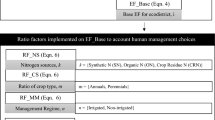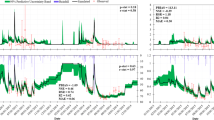Abstract
The IPCC methodology was used to provide farm-scale estimates of N2O emissions from 2 dairy farms in S.W. England. Emissions were 16.5 and 15.9 kg N2O-N per ha from Farm A and B, respectively, but a large degree of uncertainty was associated with these estimates (range 5.5–50.1 and 4.6–42.5 kg N2O-N per ha for Farm A and B, respectively). The generalised assumptions and emission factors employed in this methodology can be refined at a farm scale, where more detailed information is available. Two alternative methodologies were therefore developed. The first was an improved IPCC approach using emission factors based on current literature and approaches and incorporating predictions of leached N from an existing UK model (NCYCLE). The second used the process-based model DNDC to provide estimates of N2O emission from soil. Using the improved IPCC approach, total emission was 5.1 and 8.9 kg N2O-N per ha from Farm A and B, respectively. Emission from the soil sector was decreased by 64% and 23% for Farm A and B, respectively, relative to the IPCC method. The decrease in the soil sector was largely due to a reduction in emission from grazing animals and applied animal manures. The use of NCYCLE-based estimates of nitrate leaching in the improved IPCC approach resulted in a 77% and 61% reduction in indirect emission at Farms A and B, respectively, reducing both the total emission and the proportion of the total that was due to the indirect sector. The large effect of components of the indirect sector calculations on IPCC estimates was demonstrated in a sensitivity analysis of the methodology. Data on which to base estimates of emission from indirect sources remain scarce. Preliminary measurements of indirect losses on a farm taken over 6 months confirm that indirect sources make a substantial contribution to the total emission. Estimates from the DNDC method of emission from the soil sector were larger than those of the other methods (8.2 and 7.0 kg N2O-N per ha from Farm A and B, respectively) . Use of a dynamic model such as DNDC for the estimation of emissions at a farm scale would provide a greatly improved capability for scenario testing and hence the development of mitigation strategies. However, some calibration and development of DNDC would be required before confident estimates of emissions from all sectors could be made.
Similar content being viewed by others
References
Allen AG, Jarvis, SC & Headon, D (1996) Nitrous oxide emissions from soils due to inputs of nitrogen from excreta return from livestock on grazed grassland in the UK. Soil Biol Biochem 28: 597–607
Bouwman, AF (1996) Direct emission of nitrous oxide from agricultural soils. Nutr Cycl Agroecosyst 46: 53–70
Bouwman AF (1990) Exchange of greenhouse gases between terrestrial ecosystems and the atmosphere. In: Bouwman AF (ed) Soils and the Greenhouse Effect, pp 61–127. Chichester, UK: Wiley and Sons
Bremner JM & Blackmer SM (1981) Terrestrial nitrification as a source of atmospheric nitrous oxide. In: Delwiche CC (ed) Denitrification, Nitrification and Atmospheric Nitrous Oxide, pp 151–170, New York: John Wiley
Brown L, Armstrong Brown S, Jarvis S C, Syed B, Goulding KWT, Phillips, VR, Sneath, RW & Pain BF (2000). An inventory of nitrous oxide emissions from agriculture in the UK using the IPCC methodology: emission estimate, uncertainty and sensitivity analysis. Agri Ecosyst Environ (in press)
Chadwick DR, Sneath RW, Phillips, VR & Pain BF (1999) A UK inventory of nitrous oxide emissions from farmed livestock. Atmos Environ 33: 3345–3354
Chambers B, Nicholson N, Smith K, Pain BF, Cumby T & Scotford I. (1999). Managing livestock manures, Booklet 2: Making better use of livestock manures on grassland. London: MAFF
Eggleston HS & Williams ML (1989) UK Emissions of carbon dioxide and methane. 1960–1987, Warren Spring Laboratory Report, Warren Spring, Stevenage
Firestone MA & Davidson EA (1989) Microbiological basis of NO and N2O production and consumption in soil, In: Andae MO and Schimel DS (eds) Exchange of trace gases between terrestrial ecosystems and the atmosphere, pp 7–22. Chichester: JohnWiley and Sons
Frolking SE, Mosier AR, Ojima DS, Li C, Parton WJ, Potter CS, Priesack E, Stenger R, Haberbosch C, Dorsch P, Flessa H & Smith KA (1998) Comparison of N2O emissions from soils at three temperate agricultural sites: simulations of yearround measurements by four models. Nutr Cycl Agroecosyst 52: 77–105
Groffman PM, Gold AJ, Jacinthe P (1998) Nitrous oxide production in riparian zones and groundwater. Nutr Cycl Agroecosyst 52: 179–186
IPCC (1997) Greenhouse Gas emissions from agricultural soils. In: Houghton JT et al. (eds) Greenhouse Gas Inventory Reference Manual. Revised 1996 IPCC Guidelines for National Greenhouse Gas Inventories. IPCC/OECD/IES. UK Meteorological Office, Bracknell, UK
Jarvis SC (1993) Nitrogen cycling and losses from dairy farms. Soil Use Manage. 9: 99–105
Jarvis SC & Pain BF (1994) Greenhouse gas emissions from intensive livestock systems: their estimation and technologies for reduction. Clim Change 27: 27–38
Jarvis SC (1999) Nitrogen Management and Sustainability. In: Cherney JH & Cherney DJR (eds) Grass for Dairy Cattle, pp 161–192. Wallingford, UK: CABI Publishing
Jarvis SC, Wilkins RJ & Pain BF (1996) Opportunities for reducing the environmental impact of dairy farm managements: a systems approach. Grass Forage Sci 51: 21–31
Li C, Frolking S & Frolking TA (1992a) A model of nitrous oxide evolution from soil driven by rainfall events: 1. Model structure and sensitivity. J Geophys Res 97: 9759–9776
Li C, Frolking S & Frolking TA (1992b) A model of nitrous oxide evolution from soil driven by rainfall events: 2. Model Applications. J Geophys Res 97: 9777–9783
Mosier A, Kroeze C, Nevison C, Oenema O, Seitzinger S & van Cleemput O (1998) Closing the global N2O budget: Nitrous oxide emissions through the agricultural nitrogen cycle. Nutr Cycl Agroecosys 52: 223–245
Oenema O, Gebauer G, Rodriguez M, Sapek A, Jarvis SC, Corre WJ & Yamulki S (1998) Controlling nitrous oxide emissions from grassland livestock production systems. Nutr Cycl Agroecosyst 52: 141–149
Palisade (1997) Guide to using @RISK. Palisade Corporation, USA
Scholefield D, Lockyer DR, Whitehead DC & Tyson KC (1991) A model to predict transformations and losses of nitrogen in UK pastures grazed by beef cattle. Plant Soil 132: 165–177
Author information
Authors and Affiliations
Rights and permissions
About this article
Cite this article
Brown, L., Jarvis, S. & Headon, D. A farm-scale basis for predicting nitrous oxide emissions from dairy farms. Nutrient Cycling in Agroecosystems 60, 149–158 (2001). https://doi.org/10.1023/A:1012659801484
Issue Date:
DOI: https://doi.org/10.1023/A:1012659801484




